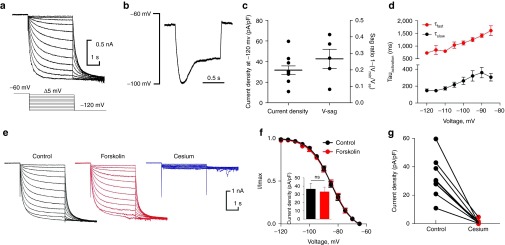Figure 6.

Human pluripotent stem cells (hPSC)-sensory express a fast cAMP-insensitive Ih indicative of HCN1 ion channels. (a) Hyperpolarization-activated currents (Ih) were observed in hPSC-sensory when cells were voltage-clamped from a Vh of −60 mV to hyperpolarizing test voltage steps from −65 to −120 mV in 5 mV increments (bottom panel). Utilizing tail current analysis (see Materials and Methods), the V1/2 of activation of Ih in hPSC-sensory was −84.7 ± 1.0 mV (n = 5). (b) Voltage relaxations (v-sag) typical of HCN-expressing neurons were observed in response to a hyperpolarizing injection in current-clamp mode (60 pA in this representative cell). (c) The average current density measured in voltage-clamp in response to a −120 mV voltage step was 31.8 ± 4.2 pA/pF (n = 10) in current-clamp mode an average of 0.3 ± 0.1 v-sag (n = 5) was observed in response to current injection achieving target voltages of ~−100 mV. (d) Activation kinetics were analyzed by fitting a double exponential to describe two activation rates (τfast and τslow). τfast kinetic analysis demonstrate a rapidly activating Ih similar to those observed in recombinant HCN1 ion channels. (e) Family of Ih traces in response to voltage steps as shown in a. In these examples, the cell was either measured in control conditions, forskolin-treated or in the presence of the Ih blocker cesium. (f) Voltage-activation curves for Ih were not affected following forskolin treatment (V1/2 in control = −84.74 ± 1.0 mV and forskolin-treated = −84.0 ± 1.1 mV; n = 5; not significantly different). Likewise, current densities measured at −120 mV were not different between control (36.4 ± 6.8 pA/pF) and forskolin-treated (33.0 ± 5.6 pA/pF) cells. (g) Ih was completely blocked by a short application of the HCN channel blocker cesium (control = 31.8 ± 4.2 pA/pF and cesium = 0.9 ± 0.4 pA/pF, n = 10).
